#imperobator antarcticus
Text

Imperobator antarcticus! Using this as a header 🦖
73 notes
·
View notes
Text

Speculative reconstruction of the mysterious theropod Imperobator antarcticus from the Maastricht of Antarctica. A fragmented leg and teeth of this animal were found in the Snow Hill Formation (James Ross Island). Initially, they were attributed to dromaeosaurid (the dinosaur was nicknamed "Naze dromaeosaurid" in honor of the place of discovery), despite the absence of a sickle-shaped claw. In 2019, the taxon finally received an official name meaning "imperial warrior from Antarctica". He was excluded from dromaeosaurids, referred to basal deinonychosaurs. Judging by the remains, it grew to the size of giant dromaeosaurids of the Utahraptor type. Teeth found with bones are typical of predatory maniraptorans, although the mere association with leg bones hardly confirms the carnivory of the animal.
Black ballpoint pen and black colored pencil, 2023.
#imperobator antarcticus#imperobator#deinonychosaur#maniraptoran#theropod#prehistoric planet#paleoart
70 notes
·
View notes
Text

Imperobator
Imperobator — рід тероподів з групи Paraves, що мешкали під час маастрихтського етапу пізньої крейди на території сучасної Антарктиди. До нього належить єдиний вид, I. antarcticus, знайдений в острівній формації Сноу-Хілл. У 2019 році автори опису припустили, що Imperobator був приблизно такого ж розміру, як і Utahraptor.
Повний текст на сайті "Вимерлий світ":
https://extinctworld.in.ua/imperobator/
#imperobator#theropod#late cretaceous#apple#david attenborough#bbc#prehistoric planet#ua#dinosaurs#antarctica#hans zimmer#paleoart#paleontology#prehistoric#animals#digital art#fossils#cretaceous#extinct#sciart#article#палеонтологія#палеоарт#ukraine#ukrainian#мова#україна#українцівтамблері#тварини
86 notes
·
View notes
Text




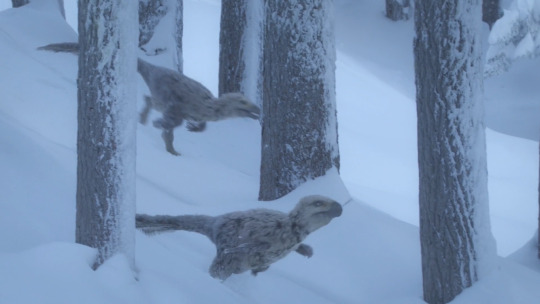

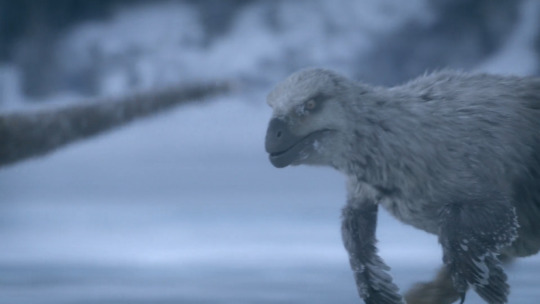


Life of our Prehistoric Planet: Imperobator antarcticus.
#prehistoric planet#prehistoric planet 2#imperobator#dinosaurs#theropod#mine#the one dinosaur i wanted to see most that wasn't in the first season even if its name sounds like something yabai#q
53 notes
·
View notes
Text
This Week in Dinosaur News: Running robot and Chinese deity dinosaurs
This Week in #Dinosaur #News: A running #Caudipteryx #robot, Chinese deity dinosaurs, and a new dinosaur from Antarctica
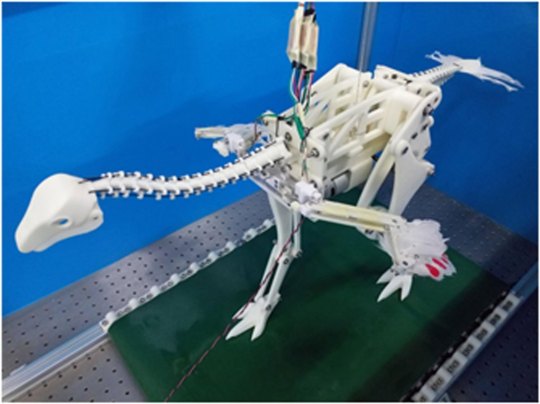
Running Caudipteryx. Used to demonstrate how running caused its wings to flap
From: doi.org/10.1371/journal.pcbi.1006846
Here’s what came out this week in dinosaur news:
The foot of a new dinosaur, Imperobator antarcticus, was found in Antarctica source
Xingtianosaurus ganqi was found in China and named after a headless deity and his weapon source
A robotic Caudipteryx and baby ostriches may…
View On WordPress
#alaska#animatronic Velicipastor#Antarctica#antarcticus#archaeopteryx#birds#Caudipteryx#china#Dark Sky#dinosaur#dinosaur national monument#dinosaurs#fly#foot#Fortnite#ganqi#headless#i know dino#Imperobator#Jurassic#jurassic world#Jurassic World the Ride#lambeosaurine#london#new jersey#north slope#ostrich#robot#robotic#Romania
25 notes
·
View notes
Text
In the Field: Following the Work of a Paleontologist
Introduction by Jessica Sperdute
Edited by Matt Lamanna
With 22 million specimens housed at Carnegie Museum of Natural History (CMNH) and nearly 10,000 on display at any given time, chances are you’ve seen a dinosaur or two during your museum visits. But have you ever wondered how those dinosaurs get to the museum after they’re found? Or how we know where to dig for them in the first place?
What is a Fossil?
Fossils are the remains of animals, plants, and other ancient life that have been preserved in rock layers, or sediment. Fossils can include things such as leaves, skin, feathers, hair, footprints, and, most commonly, hard material such as wood, shells, teeth, and bones. Even poop can be fossilized! Many kinds of fossils are rare, and studying them can help us understand how the world looked tens of thousands or even millions of years before our time. Scientists who study fossils are known as paleontologists.
Looking at the Layers
Paleontologists use many tools to help them find fossils, but the key to knowing where fossils may be hidden underground lies with rocks—massive layers of rocks, called strata, are piled onto one another over time. These layers of different rocks can tell us not only what type of rock the layer is made of, but also approximately how old the layer is. The study of rock layers is called stratigraphy, and paleontologists use it to find potential fossil beds. For instance, if a paleontologist is looking specifically for fossils of dinosaurs, they would use stratigraphy to locate exposed layers of sedimentary rocks that formed at the time when dinosaurs lived and died—the Mesozoic Era. Once rocks from the Mesozoic Era are found in a location, the paleontologist goes to that location to hunt for fossils.
Big Prospects
Finding the right type of strata is only half the work of finding fossils; once paleontologists arrive at the field site, they need to physically walk around and search for clues that fossils may be around or underneath them. This is called prospecting, and the best place to prospect is usually at the base of a hill. Wind and rain will erode or gradually wear away rocks, allowing some fossils to break loose from higher sediments and roll downhill. If a fossil fragment is found, the team can then search the area to see if there may be other, more complete fossils—oftentimes higher up the hill and still embedded in rock.
Once prospecting has yielded an area where a fossil is likely to buried, the team can begin to block out the site and start digging. They use a wide variety of tools—even household items like paintbrushes, shovels, and hammers—to uncover fossils without damaging them. Records are taken of this step-by-step process to ensure all the data, from the precise location of the dig site, to the type of fossils found and their spatial relationships to one another, and even the measurements of the quarry, is kept for further study.
Safety First
The team has found a fossil, dug it up, and recorded the data. Now what? Once a fossil has been carefully excavated, it needs to be protected. Most fossils are delicate, so to transport them, especially larger ones, paleontologists use a method called plaster jacketing to protect them. First, they wrap the fossil in soft material such as paper towels, toilet paper, or aluminum foil to cover it. Then they wrap the covered fossil in strips of burlap that have been soaked in liquid plaster. This method is like using a cast on broken bones. After the plaster hardens, it acts as a shield. When the fossil has been safely transported and is ready to be studied or put on display at a place like Carnegie Museum, the paleontologist can gently cut away the plaster without damaging the fossil inside.
Paleontologist Photos
Dr. Matt Lamanna, Mary R. Dawson Associate Curator of Vertebrate Paleontology here at CMNH, has shared some of his favorite photos of his work at previous fossil dig sites. Look at the photos—do you recognize some of the locations, the tools that Dr. Lamanna is using, or the fossils that he’s digging up?

Here, Carnegie Museum of Natural History Mary R. Dawson Associate Curator of Vertebrate Paleontology Dr. Matt Lamanna is pointing at two ribs of a small—possibly baby—sauropod (long-necked plant-eating dinosaur) projecting from a rock face in the Bahariya Oasis of Egypt in 2001. He’d found this small sauropod only minutes before this photo was taken. Sometimes prospecting yields great finds! Credit: Mandi Lyon.

Dr. Matt Lamanna (right) on an expedition that found dozens of roughly 120-million-year-old fossil bird skeletons, mostly belonging to the species Gansus yumenensis, in the Changma Basin of Gansu Province, China in 2004. Lamanna is with collaborator Hailu You. Credit: Ken Lacovara.

In this photo, also taken in 2004 in Gansu Province, China, Dr. Lamanna poses next to the ribs of a giant sauropod—these ribs were just part of the massive skeleton that was discovered. Credit: Hailu You.

Dr. Lamanna on the expedition that found the new and gigantic titanosaur (a type of sauropod, again, a long-necked plant-eating dinosaur) Dreadnoughtus schrani in Santa Cruz Province, Argentina in 2005. Lamanna is shoveling loose rock out of the Dreadnoughtus quarry. Credit: Ken Lacovara.
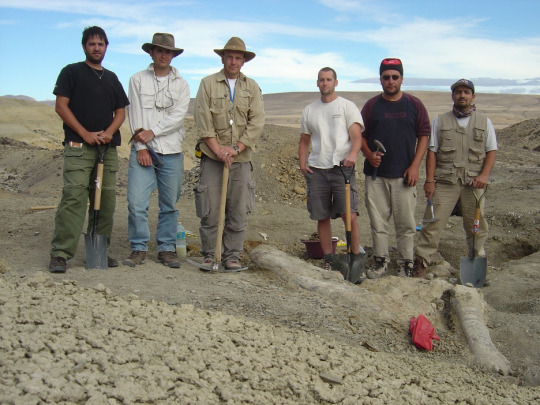
Members of the expedition from Drexel University, the Universidad Nacional de la Patagonia San Juan Bosco, and CMNH that found the giant titanosaur Dreadnoughtus in Santa Cruz Province, Argentina in 2005 (left to right: Lucio Ibiricu, Chris Coughenour, Ken Lacovara, Matt Lamanna, Marcelo Luna, and Gabriel Casal). The huge femur (thigh bone) and tibia (shin bone) of Dreadnoughtus are visible in the foreground. Credit: Matt Lamanna.
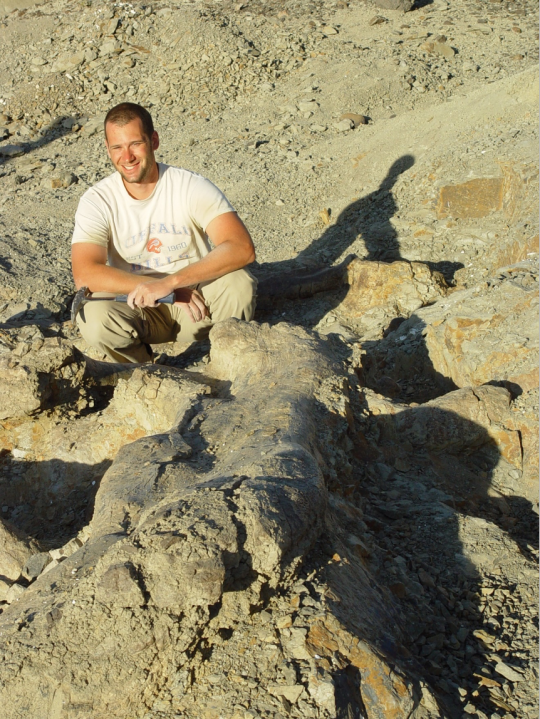
Dr. Lamanna on the expedition that found the titanosaur Dreadnoughtus in Santa Cruz Province, Argentina in 2005. He’s sitting behind the 1.91 m (6 ft 3 in) femur, or thigh bone, of Dreadnoughtus not long after its discovery. Credit: Chris Coughenour.
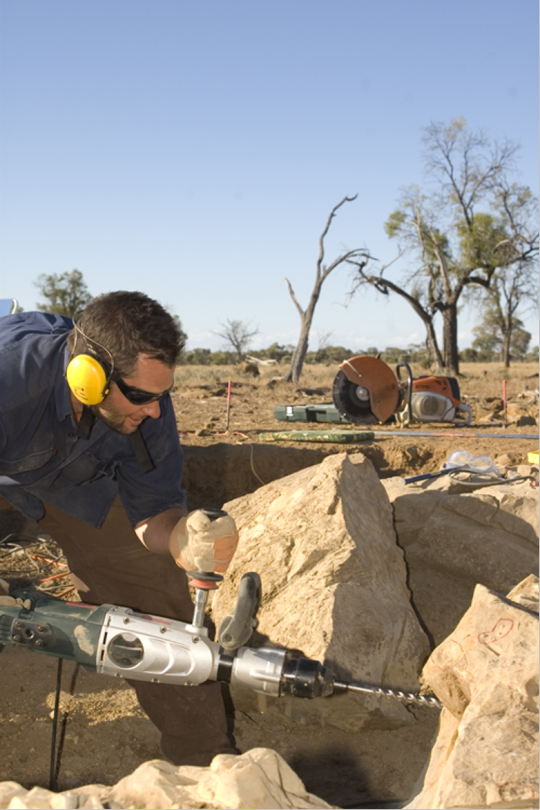
Here, Dr. Lamanna is using a rock drill (one of his very favorite field tools!) to help collect the skeleton of a new armored dinosaur in Queensland, Australia in 2008. Credit: Steve Salisbury.

Dr. Lamanna (right) with collaborator Gabriel Casal making a plaster-and-burlap jacket to protect bones of the titanosaur Sarmientosaurus musacchioi in Chubut Province, Argentina in 2008. Credit: Mandi Lyon.

Lamanna on the day he found the only known fossil of the new, ~90-million-year-old crab Hadrocarcinus tectilacus on James Ross Island, Antarctica in 2009. Credit: Patrick O’Connor.
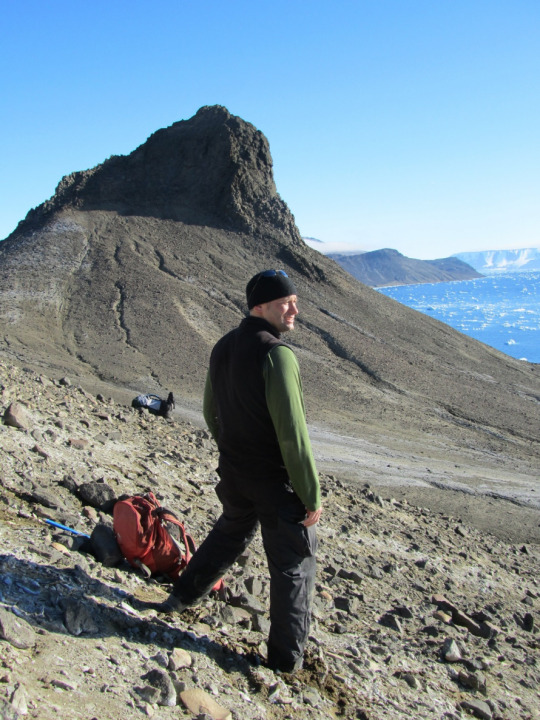
Here’s another photo of Lamanna on James Ross Island of Antarctica, this time in 2011. The team found tooth and bone fragments of the theropod—meat-eating dinosaur—Imperobator antarcticus at this site. Credit: Meng Jin.
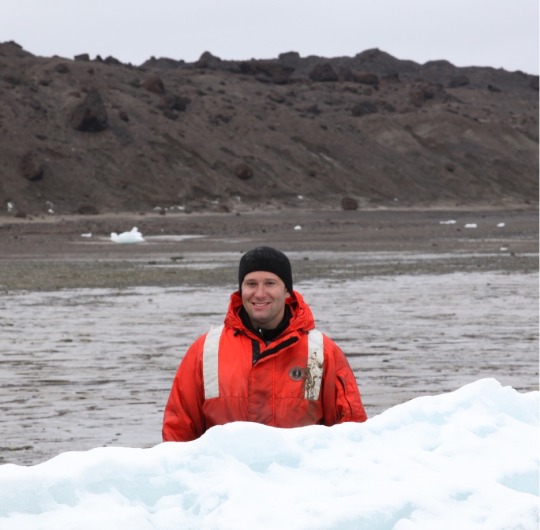
During the 2011 Antarctic expedition, Lamanna and his fellow paleontologists also found lots of fossils on nearby Vega Island, especially those of approximately 70-million-year-old birds. Credit: Meng Jin.
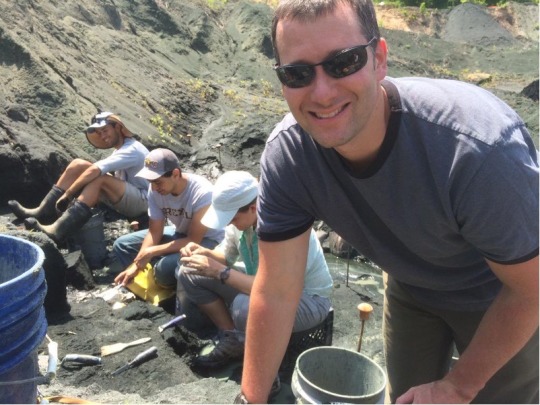
In this photo from 2015, Lamanna is shown collecting fossils in a New Jersey quarry with a research team from Drexel University, who were uncovering marine creatures from the very end of the Mesozoic Era. Credit: Ken Lacovara.
Jessica Sperdute is a Gallery Presenter II Floor Captain and Lead Animal Husbandry Specialist in CMNH’s Lifelong Learning Department. Museum staff, volunteers, and interns are encouraged to blog about their unique experiences and knowledge gained from working at the museum.
#Carnegie Museum of Natural History#Super Science Days#Vertebrate Paleontolgy#Paleontology#Dinosaurs#Fossils
87 notes
·
View notes
Text
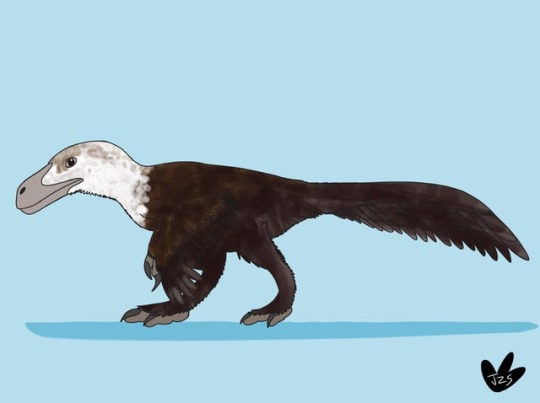
Imperobator antarcticus (Antarctic powerful warrior), formerly known as “Naze Dromaeosaur.”
6 notes
·
View notes
Photo
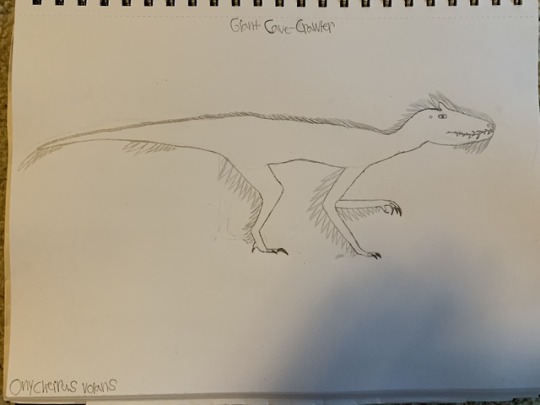
Giant Cave-Crawler
Kingdom: Animalia
Phylum: Chordata
Class: Reptilia
Clade: Diapsida
Clade: Archosauria
Clade: Dinosauria
Order: Saurischia
Suborder: Theropoda
Clade: Maniraptoromorpha
Clade: Maniraptoriformes
Clade: Maniraptora
Clade: Pennaraptora
Clade: Paraves
Family: Onycheiridae
Genus: Onycheirus
Species: O. volans (”flying clawed hand”)
Ancestral species: Imperobator antarcticus
Time period: early Pliocene to modern day (5.333 million years ago to present).
Information: a descendant of an already-bizarre genus of paravians, which bear a close relation to dromeosaurs and troodonts, the Giant Cave-Crawler is around 15 feet in length and stands around 6 feet tall. Found deep down in the Akamanucha cave systems of Xenogaea, it hunts in the bioluminescent forests, feeding on a variety of prey items. The small crests over its brows are found in males only, perhaps signifying that they once had an evolutionary purpose in mating rituals. As its depiction here would suggest, it is a biped, and is also a considerably-good climber. The small feather patches on its body are black with blue tips while its skin is black but has a large, yellow bioluminescent streak running down its body, starting from its crests and gradually tapering off at its tail. They communicate in loud, bark-like roars to one another. Their eyesight is also decently-developed, allowing them to see their otherwise-dull world in a full range of colors. Assessment: despite its predatory nature, it does not show unprovoked aggression towards the drones that were sent down into the system. Further examination required.
0 notes
Text
timelapse of the art I posted earlier!
1 note
·
View note
Text
Indosuchus - Episode 232
Dinosaur of the day Indosuchus, an Indian abelisaurid from the Late Cretaceous.
In dinosaur news this week:
The foot of a new dinosaur, Imperobator antarcticus, was found in Antarctica
Xingtianosaurus ganqi was found in China and named after a headless deity and his weapon
A robotic Caudipteryx and baby ostriches may help explain how birds learned to fly
New measurements of the Berlin Archaeopteryx appear to show that it could fly (and not just glide)
In Ogdensburg, New Jersey, the Sterling Hill Mining Museum has new dinosaur tracks on display
A lambeosaurine from Alaska’s North Slope has made it to the Perot Museum in Dallas, Texas
Dinosaur National Monument has been recognized by the International Dark Sky Association
Dino Parc Rasnov in Romania recently doubled in size
In London, there will be a 12 week run of Dinosaur World Live at the Troubadour Wembley Park Theatre
Smithsonian’s National Zoo is having a dino summer from June to August with animatronic dinosaurs
A new movie called Velicipastor is skipping the theaters
Jurassic World the Ride is set top open at Universal Studios, CA this summer
Fortnite has dinosaurs in the desert biome and gives a reward if you dance with them
To get access to lots of patron only content check out https://www.patreon.com/iknowdino
For links to every news story, all of the details we shared about Indosuchus, and our fun fact check out https://iknowdino.com/Indosuchus-Episode-232/
Check out this episode!
4 notes
·
View notes